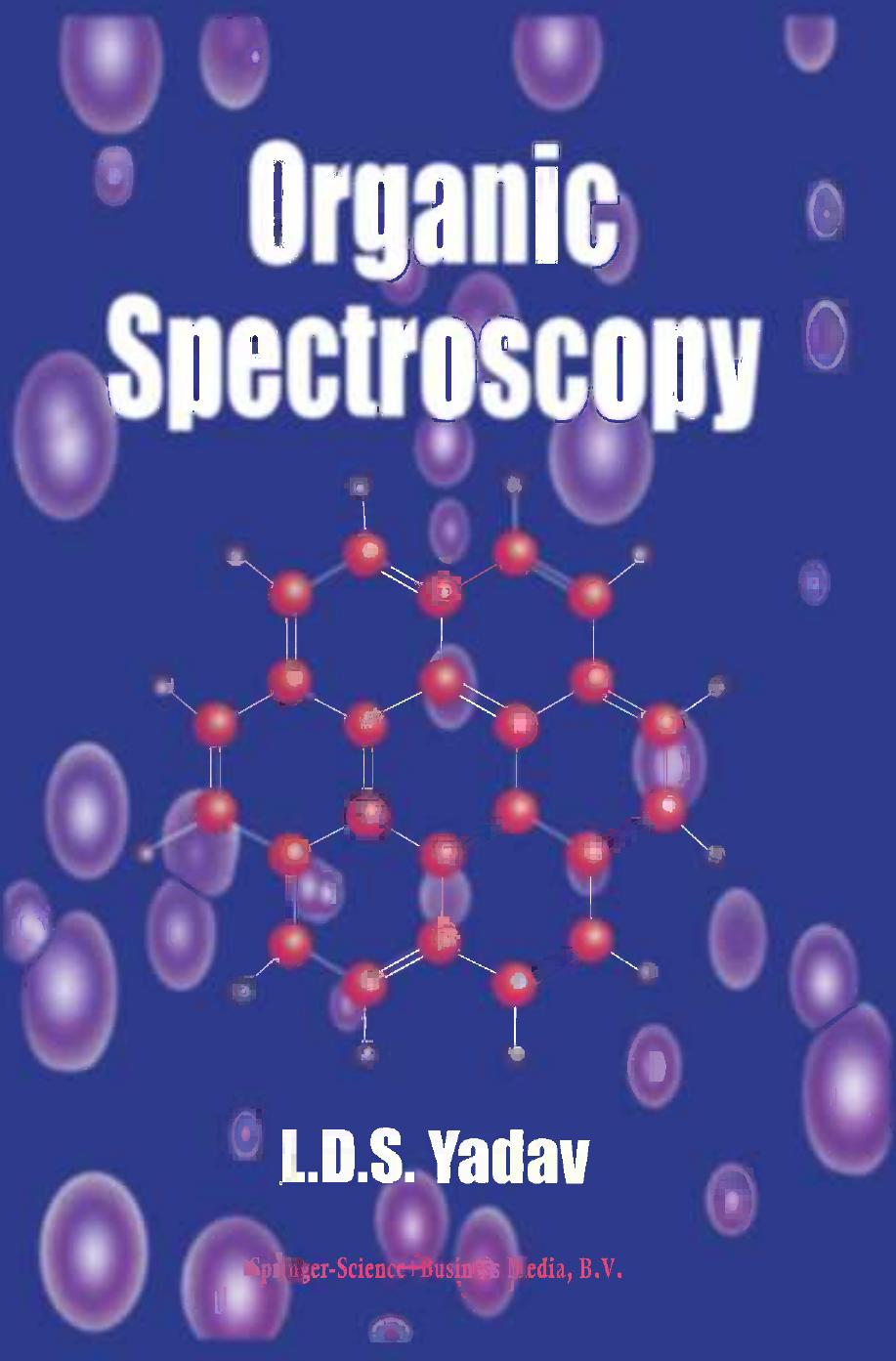
书籍简介
- Introduction to Spectroscopy (Spectrometry)
- Ultraviolet (UV) and Visible Spectroscopy
- Infrared (IR) Spectroscopy
- Raman Spectroscopy
- Proton Nuclear Magnetic Resonance(PMR or $\ce{^1H}$ NMR) Spectroscopy
- $\ce{^13C}$ NMR Spectroscopy
- Electron Spin Resonance (ESR) Spectroscopy
- Mass Spectroscopy (MS)
- Spectroscopic Solutions of Structural Problems
本书pdf是文字识别版,影印质量很好。
Introduction to Spectroscopy (Spectrometry)
1.1 Spectroscopy and Electromagnetic Radiations
1.2 Characteristics of Electromagnetic Radiations
1.3 Solved Problems
1.4 Electromagnetic Spectrum
1.5 Absorption and Emission Spectra
Ultraviolet (UV) and Visible Spectroscopy
2.1 Introduction
2.2 Absorption Laws and Molar Absorptivity
2.3 Instrumentation
2.4 Sample Handling
2.5 Theory (Origin) of UV-Visible Spectroscopy
2.6 Electronic Transitions
2.7 Formation of Absorption Bands
2.8 Designation of Absorption Bands
2.9 Transition Probability: Allowed and Forbidden Transitions
2.10 Certain Terms Used in Electronic Spectroscopy: Definitions
2.11 Conjugated Systems and Transition Energies
2.12 Solvent Effects
2.13 Woodward-Fieser Rules for Calculating $\lambda_{max}$ in Conjugated Dienes and Trienes
2.14 Polyenes and Poly-ynes
2.15 Woodward-Fieser Rules for Calculating $\lambda_{max}$ in $\alpha,\beta$-Unsaturated Carbonyl Compounds
2.16 Dicarbonyl Compounds
2.17 $\alpha,\beta$-Unsaturated Carboxylic Acids and Esters
2.18 Benzene and Its Derivatives
2.19 Polynuclear Aromatic Compounds
2.20 Non-benzenoid Aromatic Compounds
2.21 Heteroaromatic Compounds
2.22 Applications of Ultraviolet and Visible Spectroscopy
Infrared (IR) Spectroscopy
3.1 Introduction
3.2 Instrumentation
3.3 Sample Handling
3.4 Theory (Origin) of Infrared Spectroscopy
3.5 Number of Fundamental Vibrations
3.6 Calculation of Vibrational Frequencies
3.7 Factors Affecting Vibrational Frequencies
3.8 Characteristic Absorptions in Common Classes of Compounds
3.9 Fingerprint Region
3.10 Applications of Infrared Spectroscopy
3.11 Interpretation of Infrared Spectra
3.12 Some Solved Problems
Raman Spectroscopy
4.1 Introduction
4.2 Raman Effect and Origin of Raman Spectroscopy
4.3 Theories of Raman Effect and Raman Spectroscopy
4.4 Zero-Point Energy
4.5 Vibrational Raman Spectra
4.6 Pure Rotational Raman Spectra
4.7 Types of Molecules and Rotational Raman Spectra
4.8 Vibrational-Rotational Raman Spectra
4.9 Polarization of Raman Lines
4.10 Rule of Mutual Exclusion
4.11 Instrumentation
4.12 Sample Handling
4.13 Applications of Raman Spectroscopy
4.14 Difference Between Raman and Fluorescence Spectra
4.15 Difference Between Raman and IR Spectra
4.16 Some Solved problems
Proton Nuclear Magnetic Resonance(PMR or $\ce{^1H}$ NMR) Spectroscopy
5.1 Introduction
5.2 Theory
5.3 Instrumentation
5.4 Sample Handling
5.5 Shielding, Deshielding and Chemical Shift
5.6 Measurement of Chemical Shift: NMR Scale
5.7 Factors Affecting Chemical Shift
5.8 Number of PMR Signals: Equivalent and Nonequivalent Protons
5.9 Peak Area and Proton Counting
5.10 Spin-Spin Splitting: Spin-Spin Coupling
5.11 Coupling Constant (J)
5.12 Analysis (Interpretation) of NMR Spectra
5.13 Nomenclature of Spin Systems
5.14 Magnetic Equivalence
5.15 Spin-Spin Coupling of Protons with Other Nuclei
5.16 Protons on Heteroatoms: Proton Exchange Reactions
5.17 Simplification of Complex NMR Spectra
5.18 Nuclear Overhauser Effect (NOE)
5.19 Applications of PMR Spectroscopy
5.20 Continuous Wave (CW) and Fourier Transform (FT) NMR Spectroscopy
5.21 Some Solved Problems
$\ce{^13C}$ NMR Spectroscopy
6.1 Introduction and Theory
6.2 Sample Handling
6.3 Common Modes of Recording $\ce{^13C}$ Spectra
6.4 Chemical Shift Equivalence
6.5 $\ce{^13C}$ Chemical Shifts
6.6 Factors Affecting $\ce{^13C}$ Chemical Shifts
6.7 $\ce{^13C}$ Chemical Shifts (ppm from TMS) of Some Compounds
6.8 Spin-Spin Coupling
6.9 Effect of Deuterium Substitution on CMR Signals
6.10 Use of Shift Reagents
6.11 Applications of CMR Spectroscopy
6.12 Some Solved Problems
Electron Spin Resonance (ESR) Spectroscopy
7.1 Introduction
7.2 Theory
7.3 ESR Absorption Positions: The $g$ Factor
7.4 Instrumentation
7.5 Working of an ESR Spectrometer
7.6 Sample Handling
7.7 Sensitivity of an ESR Spectrometer
7.8 Multiplet Structures in ESR Spectroscopy
7.9 Interpretation of ESR Spectra
7.10 Double Resonance (or Double Irradiation) in ESR Spectroscopy
7.11 Applications of ESR Spectroscopy
7.12 Comparison Between NMR and ESR Spectroscopy
7.13 Some Solved Problems
Mass Spectroscopy (MS)
8.1 Introduction
8.2 Ionization Methods
8.3 Molecular and Fragment Ions
8.4 Instrumentation
8.5 Double Focusing Mass Spectrometers
8.6 Mass Spectrum and the Base Peak
8.7 Recognition of the Molecular Ion (Parent) Peak and Detection of Isotopes
8.8 Confirmation of the Recognized Molecular Ion Peak
8.9 Multiply Charged Ions
8.10 Metastable Ions or Peaks
8.11 Applications of Mass Spectroscopy
8.12 Representation of Fragmentation Processes
8.13 Factors Governing General Fragmentation Processes
8.14 Examples of General Fragmentation Modes
8.15 Fragmentation Modes of Various Classes of Organic Compounds
8.16 Some Solved Problems
Spectroscopic Solutions of Structural Problems
9.1 Introduction
9.2 Some Solved Problems
Comments !